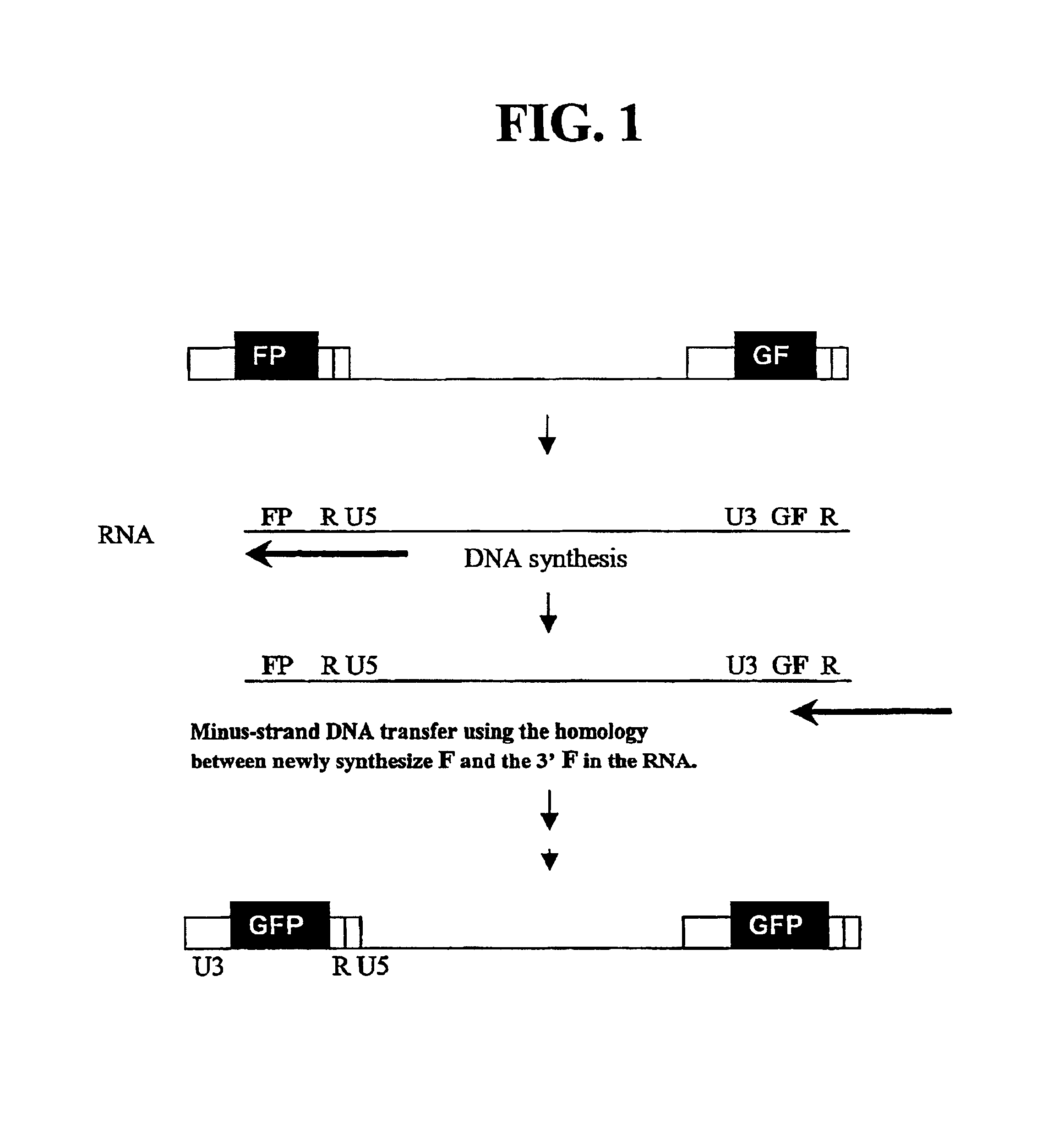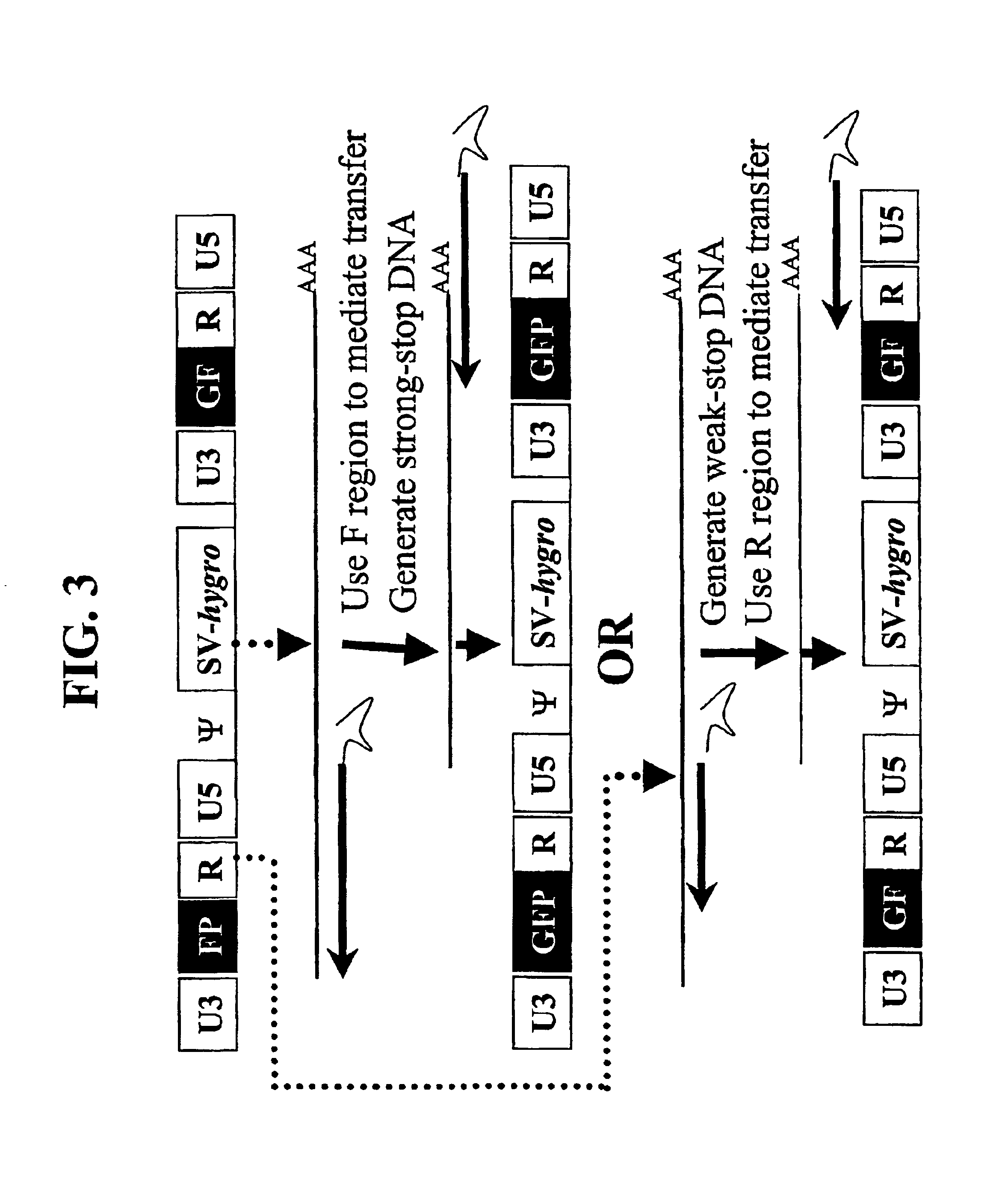Utilization of non-viral sequences for minus-strand DNA transfer and gene reconstitution
a non-viral sequence and gene technology, applied in the field of retroviral vectors, can solve the problems of duplication and reconstitution of heterologous nucleic acids in the cellular genome, and achieve the effect of reducing the number of dna insertions and reducing the number of insertions
- Summary
- Abstract
- Description
- Claims
- Application Information
AI Technical Summary
Benefits of technology
Problems solved by technology
Method used
Image
Examples
specific examples
Example 1
Materials and Methods
[0127]Construction of vectors: Plasmids pSR2, pSR5, pSR6, pMS2 were derived from pAR2 (see FIG. 2) (Yin et al., J. Virol. 71(3): 2487-2494, 1997) an MLV-based vector that contains hygromycin phosphotransferase B gene (hygro). The terminology used below, refers to several nucleic acid sequences by a specific numeration or name. When the sequence is included in a plasmid, the name of the nucleic acid sequence started is prefaced with the letter “p” (e.g. pSR2). However, when referring to a virus, the name of the nucleic acid sequence does not include the latter “p” (e.g. SR2).
[0128]pAR2 was digested to completion with AatII, self-ligated to generate pTR1, a plasmid that contained a portion of hygro and the downstream LTR. A nucleotide sequence encoding green fluorescent protein (GFP) was amplified by PCR using primers GFPp1-AscI and PPG2p-csA. The sequences of the primers used in the amplification reaction are shown below in Table 1.
[0129]
TABLE 1Primers u...
example 2
Production of Vectors to Evaluate Minus-strand DNA Transfer
[0142]A series of MLV-based retroviral vectors were constructed evaluate the reconstitution of genes using minus-strand DNA transfer. The structures of these vectors are shown in FIG. 2. The vectors used in these experiments contained cis-acting sequences necessary for the retroviral replication such as primer binding site, packaging signal (ψ+), polypurine tract, and attachment (att) sites. Most of the gag, all of the poI, and the entire env were deleted from these vectors.
[0143]Vector pAR2 contained two unmodified LTRs with hygro between the LTRs. Vectors pSR2, pSR5, pSR6, and pMS2 each contained an SV40 promoter upstream of hygro between the two LTRs. Vectors pSR6 contained two unmodified LTRs; pSR2 contained two modified LTRs each had a full-length GFP that was inserted between U3 and R. pSR5 had two modified LTRs, the upstream LTR contained the 3′ 465-bp of GFP (termed FP) between U3 and R, whereas the downstream LTR co...
example 3
Confirmation of F Region-Mediated Transfer: GFP Expression in Transfected and Infected Cells
[0154]GFP expression in all of the transfected cell pools was examined by FACS analyses. As expected, pMP1- or pSR2-transfected, drug-resistant cell pools contained significant numbers of GFP-expressing cells, generally between 45-70%. As expected, cell pools transfected with pAR2 or pSR6 did not contained a significant percentage of fluorescent cells (less then 2%) since these plasmids lack GFP. Cell pools transfected with pSR5 or pMS2 also did not contained a significant percentage of fluorescent cells (less than 2%), indicating that neither FP nor GF fragment could express fluorescent proteins.
[0155]Flow cytometry analyses were also performed on D17 cells infected with virus produced by different transfected cell pools. Drug-resistant D17 cells were pooled and were analyzed by flow cytometry; these data are summarized below in Table 3.
[0156]
TABLE 3Percent of infected D17 cells that were po...
PUM
| Property | Measurement | Unit |
|---|---|---|
| temperature | aaaaa | aaaaa |
| thermal melting point Tm | aaaaa | aaaaa |
| temperature | aaaaa | aaaaa |
Abstract
Description
Claims
Application Information
 Login to View More
Login to View More - R&D
- Intellectual Property
- Life Sciences
- Materials
- Tech Scout
- Unparalleled Data Quality
- Higher Quality Content
- 60% Fewer Hallucinations
Browse by: Latest US Patents, China's latest patents, Technical Efficacy Thesaurus, Application Domain, Technology Topic, Popular Technical Reports.
© 2025 PatSnap. All rights reserved.Legal|Privacy policy|Modern Slavery Act Transparency Statement|Sitemap|About US| Contact US: help@patsnap.com



